Tai Po Market (Tai Po) 大埔墟 | |||||||||||||
|---|---|---|---|---|---|---|---|---|---|---|---|---|---|
| Former KCR station | |||||||||||||
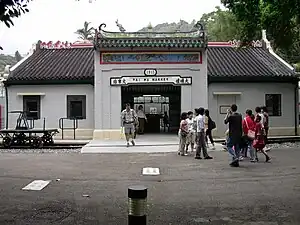 The station in 2003 | |||||||||||||
| Chinese name | |||||||||||||
| Traditional Chinese | 香港鐵路博物館 | ||||||||||||
| Simplified Chinese | 香港铁路博物馆 | ||||||||||||
| |||||||||||||
| General information | |||||||||||||
| Location | 13 Shung Tak Street,[1] Tai Po Tai Po District, Hong Kong | ||||||||||||
| Coordinates | 22°26′51″N 114°09′52″E / 22.4476°N 114.1644°E | ||||||||||||
| Owned by | Kowloon-Canton Railway Corporation | ||||||||||||
| Operated by | Kowloon-Canton Railway Corporation | ||||||||||||
| Line(s) | Kowloon–Canton Railway (British Section) | ||||||||||||
| Platforms | 2 (2 side platforms) | ||||||||||||
| Tracks | 2 | ||||||||||||
| Connections | |||||||||||||
| Construction | |||||||||||||
| Structure type | At-grade | ||||||||||||
| Platform levels | 1 | ||||||||||||
| Other information | |||||||||||||
| Status | Ceased operations, converted to museum | ||||||||||||
| Website | Hong Kong Railway Museum | ||||||||||||
| History | |||||||||||||
| Opened | 1 October 1910 | ||||||||||||
| Closed | 6 April 1983 | ||||||||||||
| Services | |||||||||||||
| |||||||||||||
| Location | |||||||||||||
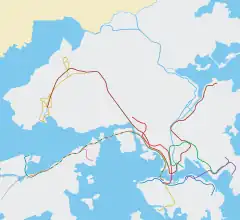 Tai Po Market (Tai Po) Location within the current MTR system | |||||||||||||
The Hong Kong Railway Museum is a railway museum in Tai Po, Hong Kong.[2] It is now under the management of the Leisure and Cultural Service Department. Opened on 20 December 1985, it is located at the site where the old Tai Po Market railway station was built in 1913.[3] Admission to the museum is free.
History
The Kowloon–Canton Railway (British Section) opened in 1910 in Tai Po Market was one of the stops in the New Territories. The station building was erected in 1913. Since then, it has acted as a centre of administration and trade, which indirectly boosted Tai Po Market's economy by bringing traders there.
The Kowloon–Canton Railway was electrified in 1983 and the station was taken out of service, with the opening of the new Tai Wo station north of it and the new Tai Po Market station south of it. One year later, the Old Tai Po Market Railway Station was declared a monument. The site, together with the buildings and relevant exhibits, were then given to Regional Council by the Kowloon-Canton Railway Corporation for the construction of the museum.
The museum opened on 20 December 1985.[4]
Architecture
The building of the station is unique in the way of architectural style among original Kowloon–Canton Railway (British Section). It is of indigenous Chinese architectural style, with many small figures decorating the exterior, such as are commonly found in existing old southern Chinese temples.
Exhibits
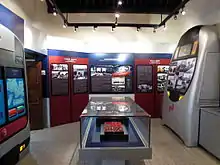
Inside the museum
On the left of the museum, there is an exhibition room of train tickets and train models of not only KCR trains but also Japanese Shinkansen and Eurostar. The further internal part of the room is a refurbished ticket office and signalling house.
Vehicles on the track
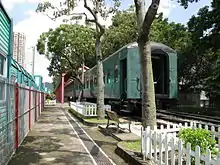
Two locomotives are on exhibition at the museum:
- EMD G12 Diesel-electric locomotive #51, introduced in Hong Kong in 1955, which is called "Sir Alexander", named after former Governor Alexander Grantham. This was the first diesel electric locomotive in Hong Kong and marked KCR's transition from steam to diesel. After a new batch of diesel locomotives arrived in Hong Kong in late 2003, the Sir Alexander retired from service. KCR Corporation staff spent more than 1000 hours restoring it to its original 1955 appearance, removing rust, repainting it dark green, and restoring the traditional logo. It was donated to the museum on 18 May 2004.[5]
- A W. G. Bagnall 0-4-4PT narrow gauge steam locomotive, restored from the Philippines in 1995. The locomotive is one of two that formerly ran on the narrow gauge Sha Tau Kok Railway line between Fanling and Sha Tau Kok. When that closed, they were used by sugar mills in the Philippines.[6] The other locomotive of the pair was also brought back to Hong Kong and is reported to be undergoing restoration.
There are seven coaches on the tracks for public viewing and appreciation of the contrast between the old and the new.
- A 1911 third-class coach, #302
- A 1921 engineering brake coach, #002
- A 1921 third-class coach, #313
- A 1955 third-class coach, #223 (an educational video room)
- A 1955 luggage coach, #229
- A 1964 first-class coach, #112
- A 1976 ordinary-class coach, #276
There are also a pump trolley and a diesel-engined railcar.
A 1:1 scale model of a non-refurbished East Rail line Metro Cammell EMU was once on display at the Museum, but was removed to make space for locomotive #51.[7]
Gallery
 Steam locomotive W.G.Bagnall 0-4-4T
Steam locomotive W.G.Bagnall 0-4-4T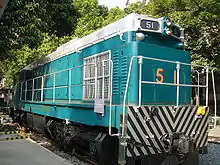 The retired Sir Alexander diesel locomotive (#51)
The retired Sir Alexander diesel locomotive (#51) Historical Coaches 223
Historical Coaches 223 Historical Coaches 313
Historical Coaches 313 Historical Coaches 302
Historical Coaches 302 The ticket office
The ticket office Inside the 1911 third-class compartment
Inside the 1911 third-class compartment Inside the 1964 First-class compartment
Inside the 1964 First-class compartment Inside the 1974 ordinary-class compartment
Inside the 1974 ordinary-class compartment Inside the 1955 third-class compartment Toilet
Inside the 1955 third-class compartment Toilet Old Tai Po Market Station sign
Old Tai Po Market Station sign To Shum Chun sign
To Shum Chun sign Tai Po Railway station Panorama
Tai Po Railway station Panorama
See also
- List of museums in Hong Kong
- Tai Wo, the local area which the former station was situated
References
- ↑ "Hong Kong Railway Museum". Hong Kong Heritage Museum. Retrieved 15 May 2022.
Address: 13 Shung Tak Street, Tai Po Market, Tai Po, Hong Kong.
- ↑ Hong Kong Railway Museum, Hong Kong Tourism Board
- ↑ "Old Tai Po Market Railway Station - Declared Monuments". Antiquities and Monuments Office. Hong Kong Government. 31 July 2018. Retrieved 18 September 2018.
- ↑ Hong Kong Railway Museum. Regional Council. 1986. p. 7.
- ↑ "KCRC donates Hong Kong's first diesel electric locomotive to Hong Kong Railway Museum". Kowloon-Canton Railway Corporation. 18 May 2004.
- ↑ "Fanling - Sha Tau Kok Branch Line" (PDF). Hong Kong Heritage Museum.
- ↑ "1:1 Yelloe-head model ". www.rrpicturearchives.net. Retrieved 16 February 2011.
External links
- Official website (in English) (in Chinese) (in Chinese)
- Attractions in Tai Po
- Hong Kong Antiquities and Declared Monuments
- Image Gallery